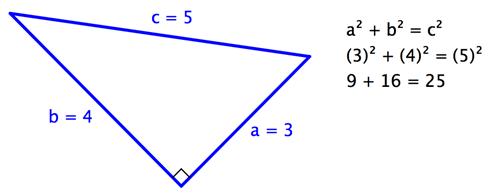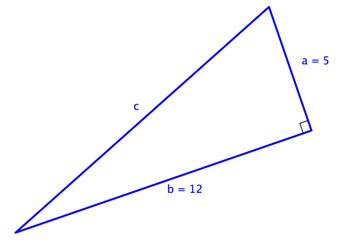
Applications of the Pythagorean Theorem
A Greek mathematician named PythagorasA Greek philosopher and mathematician who lived in the `6`th Century BC. discovered and proved an interesting property about right trianglesA triangle with one right angle.: the sum of the squares of both of the triangle’s legsIn a right triangle, one of the two sides creating the right angle., the sides that form the right angle, equals the square of the triangle’s hypotenuseThe side opposite the right angle in any right triangle—the hypotenuse is the longest side in a right triangle., the side opposite the right angle. Algebraically, the theorem is written as `a^2+b^2=c^2`. This Pythagorean TheoremThe formula used to relate the lengths of the sides in any right triangle, `a^2+b^2=c^2`. has many applications in science, art, engineering, and architecture.
This simple but powerful equation can help us gain confidence in manipulating numbers with exponents. And because right triangles are so common, it will help us understand how useful it is to be comfortable with exponential terms. The best part—we don’t even have to speak Greek.
Pythagoras studied right triangles, and the relationships between the legs and the hypotenuse of a right triangle, before proving his theory.

|
The Pythagorean Theorem If `a` and `b` are the lengths of the legs of a right triangle and `c` is the length of the hypotenuse, then the sum of the squares of the lengths of the legs is equal to the square of the length of the hypotenuse.
This relationship is represented by the formula: `a^2+b^2=c^2` |
This seems simple enough, but let’s try it with an actual right triangle to see if it is true.

The theorem is true for this triangle—the sum of the squares of both legs is the same as the square of the hypotenuse. And, in fact, it holds true for all right triangles (although, as you will see, not all measurements end up being as clean as `3`, `4`, and `5`).
Note that the Pythagorean Theorem cannot be used with just any old triangle—it only works with right triangles.
We can use the Pythagorean Theorem to find the length of the hypotenuse of a right triangle if we know the length of the triangle’s two sides. Put another way, if we know the lengths of `a` and `b`, we can find `c`.
Let’s do it.

In the triangle above, we are given measures for legs `a` and `b`: `5` and `12`, respectively. We can use the Pythagorean Theorem to find a value for the length of `c`, the hypotenuse.
|
Example |
|||
|
Problem |
Find `c` when `a = 5` and `b=12`. |
|
|
|
|
`a^2+b^2=c^2` |
Pythagorean Theorem |
|
|
|
`(5)^2+(12)^2=c^2` |
Substitute known values in for `a` and `b` |
|
|
|
`25+144=c^2` |
Simplify |
|
|
|
`169=c^2` |
Combine like terms |
|
|
|
`sqrt169=sqrt(c^2)` |
Take the square root of both sides |
|
|
Answer |
`13=c` |
|
|
Using the formula, we find that the length of `c`, the hypotenuse, must be `13`. (Although there are two possible values for `c` that make the equation work, `13` and `-13`, lengths must always be positive, so we can ignore the negative value.)
|
For which of these triangles is `(3)^2+(3)^2=r^2`?
A)
B)
C)
D)
|
We can also use the Pythagorean Theorem to find the length of a right triangle’s leg if we are given measurements for the hypotenuse and the other leg. Consider the right triangle below:

To find the length of leg `a`, we can substitute the values for `b` and `c` into the formula and then use some algebraic reasoning to find `a`.
|
Example |
|||
|
Problem |
Find `a` when `b = 6` and `c=7`. |
|
|
|
|
`a^2+b^2=c^2` |
Pythagorean Theorem |
|
|
|
`a^2+(6)^2=(7)^2` |
Substitute known values in for `b` and `c` |
|
|
|
`a^2+36=49` |
Simplify |
|
|
|
`a^2+36-36=49-36` `a^2=13` |
Isolate the `a` term |
|
|
|
`a=sqrt13` |
Take the square root of both sides |
|
|
Answer |
`a~~3.61`
|
The `sqrt13` is approximately `3.61` |
|
The Pythagorean Theorem is one of the most useful formulas in mathematics because there are so many applications of it out in the world. For example, architects and engineers use this formula extensively when building ramps:
The owners of a house want to convert a stairway leading from the ground to their back porch into a ramp. The porch is `3` feet off the ground, and due to building regulations, the ramp must start `12` feet away from the base of the porch. How long will the ramp be?
To solve a problem like this one, it often makes sense to draw a simple diagram showing the legs and hypotenuse of the triangle.

Looking at the diagram, we can identify the legs and the hypotenuse of the triangle in the problem we need to solve. We know that the triangle is a right triangle since the ground and the raised portion of the porch are perpendicular—this means we can use the Pythagorean Theorem to solve this problem. We are given the lengths of legs `a` and `b`, so we can use that information to find the length of `c`, the hypotenuse.
|
Example |
|||
|
Problem |
Find `c` when `a = 3` and `b=12`. |
|
|
|
|
`a^2+b^2=c^2` |
Pythagorean Theorem |
|
|
|
`(3)^2+(12)^2=c^2` |
Substitute known values in for `a` and `b` |
|
|
|
`9+144=c^2` |
Simplify |
|
|
|
`153=c^2` |
Combine like terms |
|
|
|
`sqrt153=sqrt(c^2)` |
Take the square root of both sides |
|
|
Answer |
`12.37~~c` |
|
|
The ramp will be just about `12.37` feet long.
The Pythagorean Theorem states that in any right triangle, the sum of the squares of the legs equals the square of the hypotenuse. This Theorem is represented by the formula `a^2+b^2=c^2`. If you know the lengths of any two sides of a right triangle, we can apply the Pythagorean Theorem to find the length of the third side.